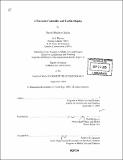| dc.contributor.advisor | Tod Machover. | en_US |
| dc.contributor.author | Sachs, David Matthew | en_US |
| dc.contributor.other | Massachusetts Institute of Technology. Dept. of Architecture. Program In Media Arts and Sciences | en_US |
| dc.date.accessioned | 2006-08-25T18:54:23Z | |
| dc.date.available | 2006-08-25T18:54:23Z | |
| dc.date.copyright | 2005 | en_US |
| dc.date.issued | 2005 | en_US |
| dc.identifier.uri | http://hdl.handle.net/1721.1/33891 | |
| dc.description | Thesis (S.M.)--Massachusetts Institute of Technology, School of Architecture and Planning, Program in Media Arts and Sciences, 2005. | en_US |
| dc.description | Includes bibliographical references (leaves 187-192). | en_US |
| dc.description.abstract | This thesis discusses the design and implementation of ARMadillo, a simple virtual environment interface in the form of a small wireless device that is worn on the forearm. Designed to be portable, intuitive, and low cost, the device tracks the orientation of the arm with accelerometers, magnetic field sensors, and gyroscopes, fusing the data with a quaternion based Unscented Kalman Filter. The orientation estimate is mapped to a virtual space that is perceived through a tactile display containing an array of vibrating motors. The controller is driven with an 8051 microcontroller, and includes a BlueTooth module and an extension slot for CompactFlash cards. The device was designed to be simple and modular, and can support a variety of interesting applications, some of which were implemented and will be discussed. These fall into two main classes. The first is a set of artistic applications, represented by a suite of virtual musical instruments that can be played with arm movements and felt through the tactile display, The second class involves utilitarian applications, including a custom Braille-like system called Arm Braille, and tactile guidance. A wearable Braille display intended to be used for reading navigational signs and text messages was tested on two sight-impaired subjects who were able to recognize Braille characters reliably after 25 minutes of training, and read words by the end of an hour. | en_US |
| dc.description.statementofresponsibility | by David Matthew Sachs. | en_US |
| dc.format.extent | 192 leaves | en_US |
| dc.format.extent | 8065973 bytes | |
| dc.format.extent | 8074057 bytes | |
| dc.format.mimetype | application/pdf | |
| dc.format.mimetype | application/pdf | |
| dc.language.iso | eng | en_US |
| dc.publisher | Massachusetts Institute of Technology | en_US |
| dc.rights | M.I.T. theses are protected by copyright. They may be viewed from this source for any purpose, but reproduction or distribution in any format is prohibited without written permission. See provided URL for inquiries about permission. | en_US |
| dc.rights.uri | http://dspace.mit.edu/handle/1721.1/7582 | |
| dc.subject | Architecture. Program In Media Arts and Sciences | en_US |
| dc.title | A forearm controller and tactile display | en_US |
| dc.type | Thesis | en_US |
| dc.description.degree | S.M. | en_US |
| dc.contributor.department | Program in Media Arts and Sciences (Massachusetts Institute of Technology) | |
| dc.identifier.oclc | 66467179 | en_US |
